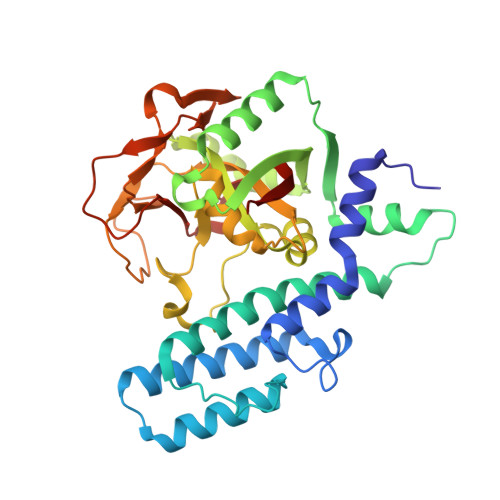Resistance-modifying agents. 9. Synthesis and biological properties of benzimidazole inhibitors of the DNA repair enzyme poly(ADP-ribose) polymerase.
White, A.W., Almassy, R., Calvert, A.H., Curtin, N.J., Griffin, R.J., Hostomsky, Z., Maegley, K., Newell, D.R., Srinivasan, S., Golding, B.T.(2000) J Med Chem 43: 4084-4097
- PubMed: 11063605
- DOI: https://doi.org/10.1021/jm000950v
- Primary Citation of Related Structures:
1EFY - PubMed Abstract:
The nuclear enzyme poly(ADP-ribose) polymerase (PARP) facilitates the repair of DNA strand breaks and is implicated in the resistance of cancer cells to certain DNA-damaging agents. Inhibitors of PARP have clinical potential as resistance-modifying agents capable of potentiating radiotherapy and the cytotoxicity of some forms of cancer chemotherapy. The preclinical development of 2-aryl-1H-benzimidazole-4-carboxamides as resistance-modifying agents in cancer chemotherapy is described. 1H-Benzimidazole-4-carboxamides, particularly 2-aryl derivatives, are identified as a class of potent PARP inhibitors. Derivatives of 2-phenyl-1H-benzimidazole-4-carboxamide (23, K(i) = 15 nM), in which the phenyl ring contains substituents, have been synthesized. Many of these derivatives exhibit K(i) values for PARP inhibition < 10 nM, with 2-(4-hydroxymethylphenyl)-1H-benzimidazole-4-carboxamide (78, K(i) = 1.6 nM) being one of the most potent. Insight into structure-activity relationships (SAR) for 2-aryl-1H-benzimidazole-4-carboxamides has been enhanced by studying the complex formed between 2-(3-methoxyphenyl)-1H-benzimidazole-4-carboxamide (44, K(i) = 6 nM) and the catalytic domain of chicken PARP. Important hydrogen-bonding and hydrophobic interactions with the protein have been identified for this inhibitor. 2-(4-Hydroxyphenyl)-1H-benzimidazole-4-carboxamide (45, K(i) = 6 nM) potentiates the cytotoxicity of both temozolomide and topotecan against A2780 cells in vitro (by 2.8- and 2.9-fold, respectively).
Organizational Affiliation:
Department of Chemistry, Bedson Building, The University, Newcastle upon Tyne NE1 7RU, UK.















